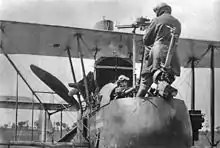Campbell Hoy
Group Captain Campbell Alexander Hoy (13 February 1893 – 9 March 1985) was a British flying ace during the First World War, credited with eleven aerial victories. He remained in the Royal Air Force post-war and served through the end of the Second World War.[1]
Campbell Alexander Hoy | |
|---|---|
| Born | 13 February 1893 South Shields, Durham, England |
| Died | 9 March 1985 (aged 92) Surrey, England |
| Allegiance | England |
| Service/ | Royal Flying Corps Royal Air Force |
| Years of service | 1914 - 1946 |
| Rank | Group Captain |
| Unit | No. 20 Squadron RAF |
| Awards | Military Cross |
Early life
Campbell Alexander Hoy was born to Henry Hoy,[2] a chemist,[3] and Margaret Anne Reid, in Newbiggin-by-the-Sea.[3] He was living there in Campbell House during 1901. He attended Armstrong College, Newcastle, then a part of the University of Durham, from 1913 onwards.[2] On 15 January 1915, Cadet Lance-Corporal Hoy from the Durham University Contingent of the Officers Training Corps was commissioned as a second lieutenant in the Northern Cyclist Battalion.[4]
Aerial service in the First World War

On 16 May 1917, he was seconded to the Royal Flying Corps (RFC) as a flying officer (observer).[5] Both he and his pilot were injured when their aircraft, Royal Aircraft Factory FE.2d s/n A6366, was shot down by German ace August Hanko of Jagdstaffel 28 on 25 May 1917.[6] Hoy began his victory string over German Albatros D.V fighters on 29 June 1917. His next nine wins manning the guns in a Royal Aircraft Factory FE.2d came while he was teamed with Richard M. Trevethan. His last win was scored with Arthur Solly as his pilot, on the evening of 9 July 1918. Hoy's final tally was five Albatros D.V fighters destroyed and six driven down out of control.[note 1][1][8]
On 25 August 1917, Hoy was promoted to lieutenant, with seniority from 1 June 1916.[9] As of 14 December 1917, he was appointed an assistant instructor in gunnery and classified as a 3rd class equipment officer.[10] On 23 January 1918, he was reclassified as a 2nd class equipment officer.[11]
Between the world wars
On 7 January 1919, he was appointed temporary captain, effective 25 October 1918, in the Technical Branch.[12] On 19 May 1919, he was selected to remain seconded as captain in the RFC, with seniority from 6 November 1918.[13] On 1 August 1919, he surrendered his commission in the Cyclist Battalion and gained a permanent commission as captain in the Royal Air Force.[14]
On 2 September 1920, Hoy married Ena Olive Ball in Ickenham. The union would produce two children—Ena Bertha Margaret Hoy and Campbell Henry Alfred Hoy.[2]
On 1 January 1926, Hoy was promoted from flying officer to flight lieutenant.[15] On 7 February 1935, he was selected for retention through age 45.[16] On 1 January 1936, he was again promoted, to squadron leader.[17] A further promotion to wing commander followed on 1 January 1939.[18]
Second World War and beyond
On 24 April 1940, Wing Commander Hoy was transferred to the Technical Branch, with a promotion to group captain.[19]
On 13 February 1946, Hoy retired.[20]
Military Cross citation
- Second Lieutenant (Temporary Lieutenant) Campbell Alexander Hoy, RFC.
- "For conspicuous gallantry and devotion to duty when acting as observer on offensive patrols. On four occasions he has shot down hostile scouts, displaying in every instance splendid determination and a very fine offensive spirit."[21]
Notes
- Note that the 9 July victory shown here with Hoy as observer is different from the 9 July victory credited on Hoy's record. The former is Hoy's tenth victory; the latter is his eleventh.[7]
References
- Citations
- "Campbell Alexander Hoy". The Aerodrome. 2015. Retrieved 3 April 2015.
- "Sixth Generation: Miss Ena Olive BALL". croker-goddard.org.uk. 2013. Retrieved 3 April 2015.
- "Sources". croker-goddard.org.uk. 2013. Retrieved 3 April 2015.
- "No. 29040". The London Gazette (Supplement). 14 January 1915. p. 477.
- "No. 30170". The London Gazette (Supplement). 6 July 1917. p. 6779.
- Guttman & Dempsey (2007), pp.79 & 94.
- "Richard Michael Trevethan". The Aerodrome. 2015. Retrieved 3 April 2015.
- Franks, et al (1997), p. 26.
- "No. 30249". The London Gazette (Supplement). 24 August 1917. p. 8789.
- "No. 30463". The London Gazette (Supplement). 8 January 1918. p. 456.
- "No. 30642". The London Gazette (Supplement). 22 April 1918. p. 4803.
- "No. 31112". The London Gazette. 7 January 1919. p. 368.
- "No. 31347". The London Gazette (Supplement). 19 May 1919. p. 6240.
- "No. 31844". The London Gazette (Supplement). 31 March 1920. p. 4011.
- "No. 33119". The London Gazette (Supplement). 1 January 1926. p. 10.
- "Royal Air Force News: Extensions of Service". Flight. XXVII (1363): 153. 7 February 1935. Retrieved 3 April 2015.
- "No. 34237". The London Gazette. 31 December 1935. p. 8408.
- "No. 34586". The London Gazette. 3 January 1939. p. 62.
- "No. 35134". The London Gazette. 11 April 1941. pp. 2115–2116.
- "No. 37571". The London Gazette (Supplement). 21 May 1946. p. 2396.
- "No. 30287". The London Gazette (Supplement). 17 September 1917. p. 9573.
- Bibliography
- Franks, Norman; Guest, Russell; Alegi, Gregory (1997). Above the War Fronts: the British Two-seater Bomber Pilot and Observer Aces, the British Two-seater Fighter Observer Aces, and the Belgian, Italian, Austro-Hungarian and Russian Fighter Aces, 1914-1918: Volume 4 of Fighting Airmen of WWI Series: Volume 4 of Air Aces of WWI. Grub Street. ISBN 189869-756-6 ISBN 978-1-89869-756-5
- Guttman, Jon & Dempsey, Harry (2009). Pusher Aces of World War I. Osprey Publishing. ISBN 978-1-84603-417-6.